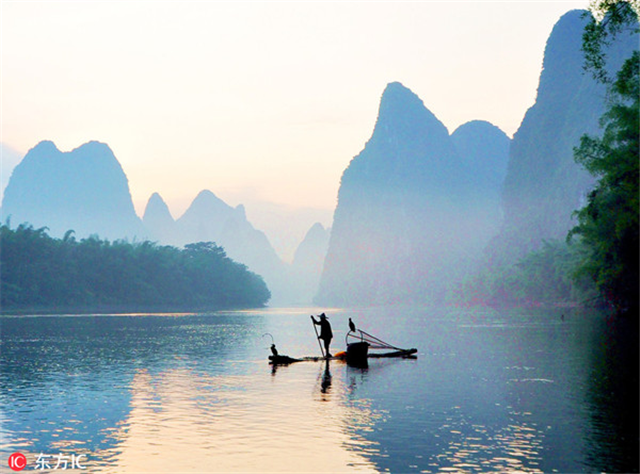A region with the greatest concentration of ethnic groups


Population: 50,126,804 (2020)
Area: A land area of 237,600 square kilometers, and a maritime area consisting of Beibu Gulf totaling 40,000 sq km
Location: South China
Located in the southern part of the mainland, Guangxi Zhuang autonomous region connects with Guangdong province to the east, neighbors Beibu Gulf to the south, and faces Hainan province across the sea. Regarded as a frontier for the cooperation between China and the Association of Southeast Asian Nations (ASEAN), Guangxi is an international pathway to ASEAN countries, a new strategic pivot area in Southwest and Central China's opening up strategy, and a dynamic portal connecting the 21st Century Maritime Silk Road and the Silk Road Economic Belt.
Climate:
Guangxi enjoys a subtropical monsoon climate with warm winters, hot summers, and abundant precipitation under the alternating influence of warm, humid air from the ocean and cold, dry air from the north.
Resources:
Guangxi has particularly large mineral reserves of nonferrous metals. Discoveries of 145 minerals have been made, accounting for 45.8 percent of proven reserves in China. Of the 97 types of mineral with proven reserves, Guangxi boasts reserves of 64 types that rank top 10 in China, of which 12 are the highest across the country.
Culture:
Guangxi is a region with the greatest concentration of ethnic groups, being populated by 12 native ethnic groups: Zhuang, Han, Yao, Miao, Dong, Mulam, Maonan, Hui, Jing, Yi, Sui, and Gelao, and another 44 ethnic groups, including Manchu, Mongolian, Korean, Bai, Tibetan, Li, and Tujia. By the end of 2013, the region's resident population of ethnic groups totaled 20.04 million, of which the Zhuang made up 16.98 million, accounting for 42.5 percent and 35.98 percent of the region’s permanent population respectively. The Zhuang is one of China's major ethnic groups.
Environment:
Areas of flat land in Guangxi are small and narrow: 69.7 percent of Guangxi is made up of mountains and hills, 27 percent of plains and terrace, and 3.3 percent of waters. The area of cultivated land is 4.43 million hectares, while the per capita area of cultivated land is only about 0.09 hectares. Mao'er Mountain in the northeast part of the region rises 2,141 meters and is the highest in South China. Following the lay of the land, the Guijiang, Liujiang, and Yongjiang rivers all flow southeast into the Xijiang River and ultimately into the Pearl River. There are some 90,000 sq km of karst landforms in the west, southwest, and northeast of Guangxi, accounting for 37.8 percent of its total area. Its karst topography is known for its crystal-clear streams, weird peaks and rocks, underground rivers, and karst caves with grotesque stalactites in shapes resembling bamboo shoots, columns, curtains, dikes, animals, and plants. Three outstanding examples of karst landforms in Guangxi are the Lijiang River scenery of Guilin, which is regarded as a masterpiece of karst landscape, Detian Waterfalls in Chongzuo, and Dalong Lake Scenic Area in Nanning.
Administrative divisions:
Guangxi has 14 prefecture-level cities under its administration, namely Nanning, Liuzhou, Guilin, Wuzhou, Beihai, Fangchenggang, Qinzhou, Guigang, Yulin, Baise, Hezhou, Hechi, Laibin, and Chongzuo, as well as seven county-level cities, 64 counties (including 12 autonomous counties), and 40 municipal districts.
Economy:
With the support of the national government, Guangxi is expanding its opening-up policies to develop a new pattern of all-around, multilevel, and wide-ranging opening-up.
In 2018, the region recorded a GDP of 2.035 trillion yuan ($302.7 billion), a year-on-year increase of 6.8 percent. The added value of industries above a designated scale was up 4.7 percent. The modern services industry saw a rapid growth, and the operation revenue of services industries above a designated scale increased 12.6 percent from January to November 2018. Its fixed-asset investment (excluding farmers) saw a year-on-year increase of 10.8 percent. Investment in high-tech manufacturing and equipment manufacturing recorded a growth of 23.5 percent and 17.1 percent respectively.
The overall employment situation in Guangxi has remained stable, and the region also witnessed a steady growth in household income and consumption. The number of new employment in urban areas totaled 421,000, and the registered urban unemployment rate has remained relatively low at around 2.34 percent in 2018. The region's per capita disposable income reached 21,485 yuan, a growth of 5.5 percent from the previous year.
The fiscal revenue of Guangxi climbed to 279 billion yuan, a growth of 7.1 percent year-on-year, and its growth rate was 1.0 percentage point faster than the previous year. Emerging sectors of strategic importance are also undergoing rapid growth. The added value of high-tech industries experienced an increase of 11.6 percent, 6.9 percentage points higher than that of industries above a designated scale.
Tourism resources:
Rich tourism resources and unique ethnic customs are also a major attraction of Guangxi. The main popular scenic spots in Guangxi include Guilin Culture and Leisure Resort, Nanning Business Exhibition Lyudu Cultural and Tourism Area, Binhai Tourism Area based on Beihai Beach, Leye Dashiwei Tiankeng Group National Geopark, Detian Transnational Waterfall Tourism Area, Guidong Religious Scenic Site Historical and Cultural Tourism Area, Hezhou Shanshui Ancient Town Ecological Cultural Area, Zhuang-Yao-Miao-Dong-Ethnic Customs Eco-tourism Area in central Guangxi, "Three Sacred" Tourist Area in Laibin and Jinxiu, and South China Border Customs Tourism Area with Pingxiang and Jingxi as the core. As of 2018, Guangxi has six national 5A-class tourist attractions and 173 4A-class tourist attractions in 14 prefecture-level cities.







